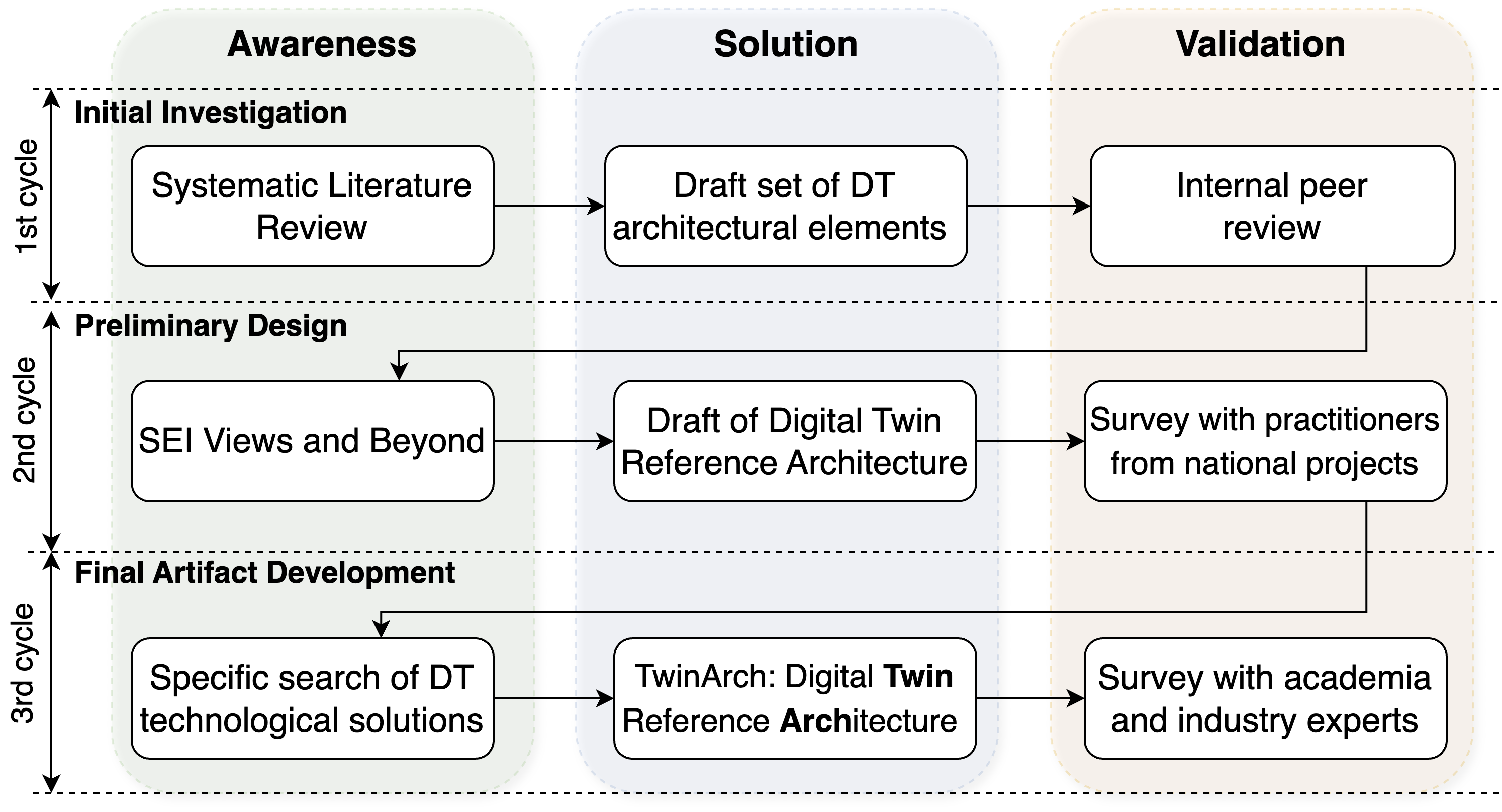Research Process and Cycles
We adopted the design science methodology, a structured process comprising three primary phases: context awareness, solution synthesis, and solution validation. Our iterative process was organized into three cycles, each encompassing the design science phases to understand the problem context, devise a solution, and validate it.

Figure 1: Design Science Process.
First Cycle: Initial Investigation
The first research cycle aimed to explore the current state of Digital Twin architectures. A Systematic Literature Review (SLR) was conducted to identify key architectural elements and pinpoint limitations in existing approaches.
We used the search string to perform a systematic literature review to understand the studies discussing DT architectures. The SLR followed the activities shown in Figure 2.

Figure 2: Systematic Literature Review Process.
In the systematic review process, we performed the search using Scopus and retrieved 5508 studies. We then applied the inclusion and exclusion criteria (IC/EC) from Table 1 below to filter the relevant studies, executed forward and backward snowballing, obtaining the final set of 45 primary studies. The results of Scopus query and the selection process based on the IC/EC criteria are available in the replicationpackage.zip
Inclusion and Exclusion Criteria
| ID | Description | Rationale |
|---|---|---|
| IC1 | The study is related to the topic under investigation. | Ensures relevance to the design and documentation of DT architectures. |
| IC2 | The study is written in English. | Ensures all reviewers can analyze the work. |
| IC3 | The study is peer-reviewed. | Guarantees quality and reliability of the source. |
| IC4 | The study is a primary study. | Avoids secondary sources that do not contribute original findings. |
| IC5 | The study was published in high-ranked venues. | Improves the credibility of included studies. |
| EC1 | The study is an earlier version of a more recent work. | Avoids redundancy in reviewed studies. |
| EC2 | The study treats Digital Twins as simulated models. | Ensures the Digital Twin is not mixed with simple simulation. |
| EC3 | The study conflates Digital Twins with Metaverse. | Avoids that Digital Twins are confused with immersive environments. |
| EC4 | The study confuses Digital Twins with AI models. | Distinguishes between proper Digital Twin and isolated AI-based models. |
Table 1: Inclusion and Exclusion Criteria.
Finally, we extracted key information from the selected primary studies using a defined classification scheme. The detailed analysis can be found in the replicationpackage.zip.
Second Cycle: Preliminary Design
In the second research cycle, the architectural elements (internally validated) were used to create the first draft of the Digital Twin Reference Architecture. The initial version of TwinArch was documented using the Software Engineering Institute Views & Beyond methodology. The draft was presented to five practitioners, including academic experts and industry professionals, participating to one of the project supporting this work. Their feedback guided further improvements that lead to the refinement of TwinArch.
Third Cycle: Final Artifact Development
The third research cycle focused on refining TwinArch based on feedback from practitioners, which highlighted the importance of incorporating existing Digital Twin platforms into the TwinArch design. To address this, a specific search of Digital Twin platforms and frameworks was conducted.
The search process involved three primary channels: (1) the Google search engine, to gain a broad overview of available platforms; (2) Google Scholar, to examine academic literature and analyses of Digital Twin technologies; and (3) GitHub repositories and official websites, to identify open-source projects with active development and community engagement.
Among the available solutions, the final selected platforms—Eclipse Ditto, Azure Digital Twins, and FIWARE— ensure representation across different categories of Digital Twin solutions, balancing openness, functionality, and cross-domain applicability. This in-depth examination provided a detailed understanding of each platform’s specific characteristics, enabling us to refine the architectural elements to better align with existing Digital Twin solutions and include practical examples.
The final validation involved an online survey of 20 Digital Twin experts from academia and industry. Details about the survey and the obtained results can be found on the dedicated webpage: evaluation.